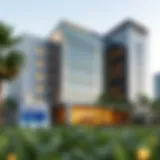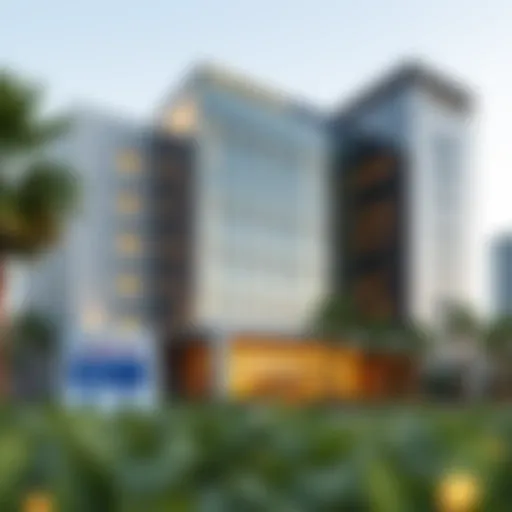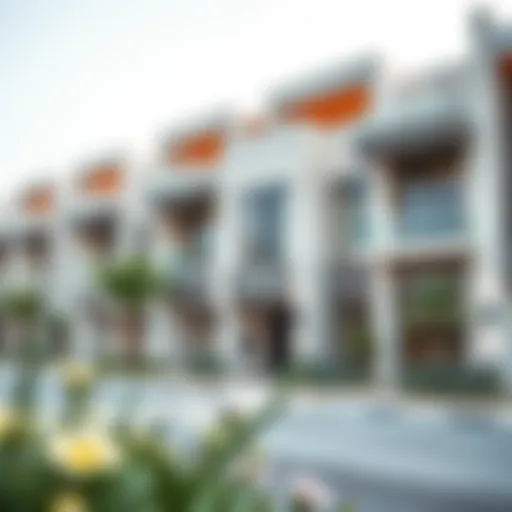Discovering the Wonders of Sharjah's Desert Garden


Intro
Nestled amidst the arid landscape of Sharjah, the Desert Garden serves as a beacon of ecological beauty and resilience. This verdant oasis not only showcases a unique collection of flora adapted to the desert climate but also plays a crucial role in advancing biodiversity and promoting education in environmental sustainability. Through the careful design and curation of its plant life, the garden presents an opportunity for tourists, locals, and ecological enthusiasts alike to engage with nature in a meaningful way.
The Desert Garden is much more than a mere collection of plants; it is a testament to the harmonious relationship between humans and nature. The significance of such green spaces within urban ecosystems cannot be understated. They serve as critical refuges for wildlife, offer educational resources, and enhance the overall quality of life in the area. With increasing urbanization, gardens like this are becoming essential not just for aesthetics, but for ecological health.
As we journey through the intricacies of this remarkable garden, we will explore its various features, the role it plays in promoting biodiversity, and the educational initiatives it supports. Ultimately, we aim to highlight the vital role that the Sharjah Desert Garden plays in fostering a greater understanding of environmental stewardship and enriching urban life.
Market Analysis
Current Trends and Insights
The increasing global emphasis on sustainability and environmental protection has turned public interest towards green spaces like the Sharjah Desert Garden. More and more, individuals and families are seeking destinations that not only entertain but also educate and inspire action toward ecological awareness. This trend is evident in visitors flocking to the garden for both leisure and learning opportunities.
Moreover, the growing insight into biodiversity’s importance indicates a shift toward preserving natural habitats. The garden's unique offerings – including its curated plant selections and the diverse wildlife they attract – resonate with the public's desire for conservation. Moreover, this aligns nicely with the local governments’ initiatives toward sustainability, reflecting a community-wide commitment to preserving ecological integrity in urban settings.
Future Projections and Opportunities
Looking ahead, the potential for the Sharjah Desert Garden to expand its educational programs and activities seems robust. There is scope for partnerships with educational institutions to further integrate the garden into local curricula, enhancing its role as a field learning site.
Investment opportunities likely abound in enhancing visitor facilities and services, not just for enjoyment but for deeper engagement with the flora and fauna unique to the region. These initiatives could cater to tourists, school groups, and eco-enthusiasts, broadening the garden's reach and impact.
Foreword to Sharjah's Desert Garden
The Sharjah Desert Garden stands as a testament to ingenuity amid a challenging environment. This unique ecological space, cradled within the vast desert of Sharjah, not only showcases a diverse array of flora but also serves various important functions for the community and the region. It embodies the essence of sustainability, education, and biodiversity—all crucial elements in today’s world. In our exploration of this remarkable garden, we will delve into its historical roots, geographical significance, and the multifaceted role it plays in promoting a green narrative in the arid landscape.
Historical Context
The history of the Sharjah Desert Garden is as rich as the soil that nurtures it. Often regarded as a visionary project by Sharjah’s leadership, the garden was established to combat environmental challenges and reshape perspectives on desert ecosystems. It isn’t merely a garden; it’s a symbol of hope crafted through careful planning and dedication. Over the years, it has evolved from a modest initiative into a significant landmark that offers valuable lessons on the importance of preserving biodiversity, especially in a desert setting.
The idea behind creating a desert garden was inspired by various traditional horticultural practices found in the region. It draws from the historical knowledge of how local flora can be nurtured to thrive even in the harshest conditions. Moreover, the garden serves to honor the cultural traditions of the UAE, embracing practices that resonate through generations.
Geographical Significance
Positioned strategically, Sharjah's Desert Garden thrives in a unique geographical setting. Nestled within the vast array of sand dunes, the garden emerges as an oasis of greenery against the backdrop of an otherwise barren landscape. This juxtaposition highlights the potential to cultivate life in arid environments, making it a poignant example for other regions facing similar climatic challenges.
The climate of Sharjah, characterized by scorching summers and mild winters, presents both challenges and opportunities for gardening. The design of the garden takes these factors into account, utilizing the natural features of the land to inform its layout and planting strategy. Utilizing native plants that have adapted to the conditions, this garden creates a micro-ecosystem that supports various species while educating visitors about local natural history.
The significance extends beyond just the aesthetic appeal; the garden functions as a vital natural resource, contributing to local air quality, mitigating urban heat, and promoting biodiversity. Thus, its geographical positioning becomes not only a site of beauty but a functional asset to the Sharjah community, integrating seamlessly into discussions of sustainability and environmental stewardship.
Design and Architecture of the Garden
The design and architecture of Sharjah's Desert Garden serve as crucial elements in achieving its role as a bastion of biodiversity and sustainable practices in the desert environment. The planning process of this garden not only focuses on aesthetics but also emphasizes functionality and ecological integrity. Elements such as layout, material choice, and integration with the natural landscape all contribute to creating a space that highlights the unique characteristics of the desert climate.
Layout and Planning
The garden’s layout was meticulously crafted to facilitate both human interaction and wildlife conservation. Walking paths curve gently to mimic the natural contours of the desert, allowing visitors to explore without disturbing the fragile ecosystems within. This design is not just about looks; it shapes experiences. Incorporating shade structures using native materials can provide much-needed respite from the sun, making it comfortable for visitors to linger longer.
- Zones: The garden is divided into distinct zones, each representing different habitats. From arid desert landscapes to more lush areas that showcase the diversity of plant life, each section tells a story of biome diversity. This separation allows for tailored care for various species, increasing the microhabitats available.
- Accessibility: Thoughtfully placed signs and maps make it easy for visitors to navigate the garden, while barriers are minimal to ensure interaction with the environment without causing damage.
Sustainable Practices
In the context of environmental awareness, the garden’s design employs sustainable practices that address the challenges posed by its arid surroundings. This includes using local materials that blend with the landscape, reducing the carbon footprint of construction and ongoing maintenance. Beyond physical structures, the philosophy of sustainability is baked into the very ethos of the garden.
- Native Plant Selection: By focusing on native plant species, the garden minimizes the need for artificial water sources and fertilizers. These plants have adapted to the local climate, requiring less maintenance in the long run, and supporting local wildlife.
- Education: The garden serves as an open-air classroom. Signage throughout the site informs visitors about sustainable gardening practices, biodiversity, and the importance of conservation efforts in desert environments.
Water Conservation Techniques
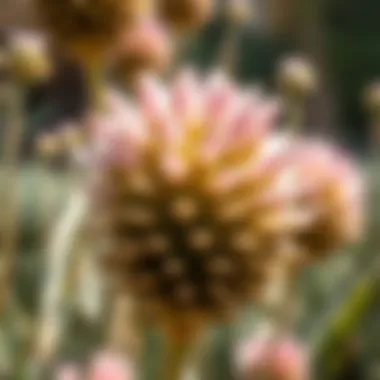

Water management in a desert garden is a complex challenge, but Sharjah’s Desert Garden has embraced innovative methods to maximize efficiency. The design incorporates several techniques aimed at conserving this precious resource.
- Rainwater Harvesting: Systems are in place to collect rainwater, funneling it into storage reservoirs. This allows the garden to utilize natural precipitation instead of relying solely on municipal supplies.
- Drip Irrigation: This method delivers water directly to the roots of plants, minimizing evaporation and runoff, a crucial strategy in a region where every drop counts. Such a technique is not just practical; it also supports a diverse plant population by providing tailored watering needs.
"The thoughtful interplay of design, ecology, and community reflects a commitment to preserving the delicate balance of nature in an urban context."
In summary, the design and architecture of Sharjah's Desert Garden exemplify a harmonious blend of aesthetics and practicality. By engaging in sustainable practices and employing smart water conservation methods, the garden stands as a model for future urban ecological projects. For those interested in sustainable living and investment opportunities in green spaces, this garden offers invaluable lessons.
Biodiversity within the Garden
Biodiversity is like the backbone of Sharjah's Desert Garden, holding together various elements that contribute to the overall health of this unique ecological space. In the context of such a stark desert landscape, the richness in plant and animal life stands as a testament to the capabilities of nature when it comes to adaptation. It offers not just aesthetic beauty but a vital resource for ecological sustainability.
The benefits of biodiversity are multifaceted. First off, a diverse ecosystem can withstand environmental changes better, ensuring that the garden remains resilient despite the hot and arid climate that characterizes Sharjah. By promoting various species, the garden provides habitats necessary for different living organisms. This leads to improved soil health and better water retention – critical factors in a desert environment.
Thus, understanding the biodiversity within the garden enables stakeholders, such as investors or expatriates, to appreciate the role these green spaces play not just for recreational use but also for environmental sustainability.
Flora of the Desert Garden
Native Plant Species
Native plant species serve a significant role in the Sharjah Desert Garden, showcasing the resilience of life in the harshest environments. One of the most notable characteristics of these plants is their ability to survive with minimal water, an essential trait for any flora in the desert.
For example, the Ghaf tree, or Prosopis cineraria, is a sought-after choice in landscaping due to its deep root system that allows it to access underground water. It also provides shade and habitats for local wildlife, making it a wonderful addition to this ecosystem. Its thick canopy is not just visually appealing but also plays a significant role in reducing soil erosion.
However, the advantages don’t come without challenges. Some native species may struggle with competition arising from invasive plants that do not internally resolve great resilience towards changes in climate.
Rare and Endangered Flora
Rare and endangered flora in the Sharjah Desert Garden hint at the delicate balance of desert ecosystems. These plants, such as the Arabian Oryx, showcase specific adaptations to survive. Their rarity draws attention to the need for conservation, further emphasizing their importance in educational programs offered by the garden.
The Acacia ehrenbergiana, for instance, is a species under threat but plays a critical role in providing essential nutrients to the soil through nitrogen fixation. Its unique feature is how it helps maintain the overall ecosystem's health. While it attracts some specialists in the botanical fields, its decreases in numbers due to urban expansion put a significant strain on conservation efforts within the garden.
Fauna in the Ecosystem
Bird Species
Bird species add another layer of vibrancy to the biodiversity in the garden. Many of these birds are native to the region, drawn by the water features and the variety of flora. Species such as the Lesser Sand Plover thrive here, as their ground-nesting habits align well with the garden's layout.
These birds offer essential ecosystem services, such as pest control and seed dispersal, promoting the growth of various plant species in the process. The ability of these creatures to adapt to urban and desert environments makes their presence in the garden a good sign of ecological health. However, habitat loss elsewhere deeply impacts their population numbers.
Insects and Pollinators
Insects and pollinators are the unsung heroes of Sharjah's Desert Garden. These tiny beings play a pivotal role in ensuring that plants can reproduce effectively. Pollinators, such as honeybees, not only help sustain local flora but also contribute significantly to overall ecosystem balance.
Understanding the symbiotic relationship between these insects and the garden's plants offers insights into the functioning of natural ecosystems. While these little critters may seem trivial, their absence could lead to drastic declines in plant species, which in turn affects other flora and fauna in the garden.
"The interconnections within an ecosystem are as vital as the strands of a spider's web, each one supporting the other."
Their unique feature is the diversity of ways they interact with flowers; some pollinate more effectively than others, which can significantly affect seed production. Maintaining a habitat with a variety of plants can help sustain these important insect populations and promote further biodiversity, creating a more resilient desert garden.
Cultural and Community Impact
The Cultural and Community Impact of Sharjah’s Desert Garden cannot be overstated. This ecological oasis serves not only as a refuge for biodiversity but also plays an instrumental role in fostering community spirit and cultural awareness. It acts as a common ground for people from diverse backgrounds, bringing them together through shared experiences in nature. The significance of this garden extends beyond its lush flora and fauna, encompassing educational initiatives, art displays, and community interaction that resonate deeply within the heart of Sharjah.
Educational Programs
Workshops and Seminars


Workshops and seminars conducted at the Sharjah Desert Garden serve a vital role in enhancing public knowledge about ecosystems and sustainability practices. These programs are tailored to a wide array of audiences, from gardening enthusiasts to environmental advocates. A particularly notable characteristic of these workshops is their practical nature; participants often engage in hands-on activities aimed at promoting conservation techniques.
A key feature of these workshops is the involvement of local experts and ecologists. Their insights provide a depth of knowledge that transforms simple interest into impactful action. Furthermore, the programs have gained popularity due to their dynamic approach — blending theory with practical work keeps participants engaged and motivated. The advantage of such initiatives lies in their ability to empower the community, fostering a sense of responsibility towards nature that can lead to long-lasting changes in environmental attitudes.
School Programs
School programs within the garden highlight the necessity of early environmental education. The tailored curriculum reflects local biodiversity and ecological challenges, ensuring relevance to students' immediate surroundings. This specificity enriches the learning experience, making it engaging whilst provoking critical thought about nature conservation.
One significant aspect of these programs is the inclusion of interactive nature trails and species identification activities. Such unique features not only spark curiosity in young minds but also cultivate a profound respect for the environment — concepts often lost in traditional classroom settings. The advantage here is clear; children educated through these initiatives grow into environmentally conscious adults, thereby influencing future generations.
Art and Cultural Exhibitions
Art and cultural exhibitions hosted at Sharjah’s Desert Garden create an avenue for local artists to showcase their work while fostering an appreciation for the rich cultural heritage of the region. These exhibitions often feature artworks that respond to themes of nature, sustainability, and the desert landscape itself. Artists are encouraged to explore the relationship between art and environmental issues, making their pieces serve as commentary on pressing ecological matters.
The community can engage with art in a meaningful way, as these exhibitions often include interactive elements such as workshops where visitors can create their own art inspired by the garden's beauty. This interaction promotes a sense of ownership over the cultural landscape while reinforcing the garden's status as a dynamic space for both reflection and action.
"The combination of art and nature within the garden presents a unique platform for dialogue, connecting communities through shared appreciation, understanding, and passion for the environment."
In essence, the cultural and community impact of Sharjah's Desert Garden thrives through educational outreach and artistic expression, nurturing a collective consciousness that promotes environmental stewardship and celebrates human creativity.
Tourism and Accessibility
The role of tourism and accessibility in Sharjah’s Desert Garden cannot be overstated. By welcoming visitors from around the globe, the garden acts as a gateway not only into the heart of the desert but also into the rich biodiversity and cultural narratives that it supports. Accessible tourism is key; ensuring that both locals and tourists can easily navigate and enjoy the garden enhances the experience, allowing them to connect with nature and each other.
Visitor Facilities
Guided Tours
Guided tours are more than just a stroll through the garden; they provide an enriching experience facilitated by knowledgeable guides who share insights into the delicate ecosystem, unique plants, and local wildlife. These tours often offer a deeper understanding of how the garden contributes to the ecological balance in the desert.
One key characteristic of guided tours is personalization. Tour guides can tailor the experience based on the interests of their group, whether it's focusing on flora, fauna, or cultural heritage. This adaptable nature makes guided tours a popular choice among visitors who might be less familiar with desert ecosystems. Visitors gain the advantage of
- Expert Insights: Learn from knowledgeable guides who can share both historical anecdotes and modern conservation efforts.
- Interactive Experience: Many tours encourage questions and discussions, allowing visitors to engage actively with the material.
However, a potential downside is that guided tours typically operate on set schedules, which may not suit every visitor's agenda. Despite this, the value added through immersive learning often outweighs the limitations, making guided tours a beneficial option for anyone keen on deepening their understanding of Sharjah's Desert Garden.
Information Centers
Information centers within the Desert Garden serve as essential hubs for visitors to gather resources and guidance. They play a pivotal role in enhancing visitor experience by providing maps, brochures, and staff assistance. This availability of information ensures that guests can maximize their time and enjoyment while exploring the garden.
One notable feature of these centers is their focus on educational outreach. They often host workshops and interactive displays that immerse visitors in the themes of sustainability and conservation. Some of the advantages of having robust information centers include:
- Centralized Resources: Easy access to all pertinent visitor information in one spot saves time.
- Engagement Opportunities: Workshops held at these centers foster a greater connection between visitors and the surrounding nature, which may lead to increased advocacy for environmental awareness.
On the downside, information centers may experience peak times, causing a bit of a rush during busy seasons. Nonetheless, their overall contribution to making the garden accessible and informative solidifies their importance.
Promotion of Eco-tourism
Sharjah's Desert Garden not only serves as a local haven for biodiversity but also stands as a trailblazer for eco-tourism in the region. By promoting sustainable practices, the garden draws eco-conscious travelers who seek more than mere leisure activities; it offers a chance to learn about and engage with the environment responsibly.
Eco-tourism promotes understanding of local ecosystems and encourages responsible environmental stewardship. Visitors are often incentivized to avoid single-use plastics and participate in conservation efforts, elevating their experience into something meaningful. This initiative aligns perfectly with global trends towards sustainable travel, making Sharjah an attractive destination for environmentally aware tourists.
In summary, the integration of visitor facilities, guided tours, and information centers along with a focus on eco-tourism highlights the commitment to accessibility and sustainability in Sharjah's Desert Garden. These elements not only enhance the visitor experience but also underscore the garden's pivotal role as a model for similar initiatives worldwide.
"The future of any environment lies in how we choose to engage with it today."
For more information on eco-tourism insights, you may want to explore resources at World Travel and Tourism Council and local initiatives at Sharjah Tourism.
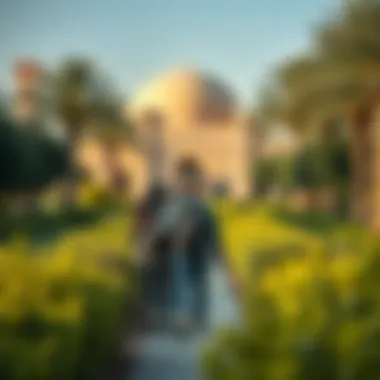

\n
Comparative Analysis with Other Desert Gardens
The comparison of Sharjah's Desert Garden with other desert gardens around the world reveals vital insights into its unique offerings, challenges, and potential for growth. Analyzing similar initiatives can guide the improvements of existing practices, helping to refine the ecological and aesthetic goals of Sharjah’s garden. By looking at these model gardens, we can not only recognize what has been achieved but also spot the gaps that need attention in efforts to promote biodiversity and environmental awareness.
Case Studies of Similar Initiatives
Examining established desert gardens, such as the Desert Botanical Garden in Phoenix, Arizona, or the Riyadh Desert Park in Saudi Arabia, lays the groundwork for understanding how different environments approach conservation and education. These gardens have effectively implemented strategies to enhance visitor experience while promoting ecological education. For instance:
- The Desert Botanical Garden focuses heavily on the conservation of desert plants and offers various educational workshops. It features a curated collection of cacti, succulents, and other xerophytes, making it a prime example of how green spaces can thrive in arid climates.
- On the other hand, Riyadh Desert Park showcases local plant species and integrates cultural elements that reflect the heritage of the region. It offers storytelling experiences aimed at younger audiences, fostering a deeper appreciation for the ecosystem and its significance.
From these examples, we observe that a well-rounded garden should include educational programs and community engagement that promote an understanding of regional flora and fauna. This, in turn, can inspire conservation efforts beyond the garden's boundaries.
Lessons Learned from Global Practices
The global practices drawn from these desert gardens emphasize sustainability and community involvement. Here are some main takeaways that can be mirrored in Sharjah’s Desert Garden:
- Community Engagement: Fostering a sense of ownership in local communities enhances the garden’s impact. Initiatives like volunteer days, community gardens, or native plant days can strengthen ties and cultivate environmental stewardship among residents.
- Diverse Educational Programs: Broad educational offerings are key. Everything from hands-on workshops focusing on desert survival skills to lectures on local wildlife helps make the garden a learning hub.
- Sustainable Horticultural Practices: Utilizing water-smart technology, composting initiatives, and organic gardening methods ensure that the garden not only survives but thrives while conserving resources.
- Cultural Integration: Incorporating local culture through art, storytelling, and performances can breathe life into gardens while respect the heritage of the region. This model has been effectively used in many gardens worldwide to attract diverse audiences.
By distilling insights from these international gardens, Sharjah’s initiative can position itself as a leader in sustainable desert landscape management. As the garden looks towards future enhancements, embracing these lessons ensures that it not only remains a vital ecological space but also a cherished community resource.
Future Developments and Sustainability
As the world grapples with the pressing issues of climate change and urbanization, the focus on sustainability has never been more crucial. This section underscores the importance of Future Developments and Sustainability in Sharjah's Desert Garden. The initiative not only aims to expand the garden's geographical footprint but also seeks to cultivate a culture of stewardship and responsibility among its visitors and the broader community. By prioritizing sustainable practices, Sharjah's Desert Garden becomes a beacon of hope in an often harsh environment.
Expansion Plans
The expansion of Sharjah's Desert Garden is pivotal for various reasons. First, it enhances the garden’s ability to accommodate more plant species, offering a richer tapestry of biodiversity. This expanded effort could include planting more native flora, which helps not only in preserving local ecosystems but also in providing a more comprehensive educational experience for visitors.
- Increased Plant Varieties: Plans indicate the introduction of additional species like Salvadora persica and Acacia tortilis, which are well-suited for arid regions.
- Enhanced Visitor Areas: Development plans also include expanding the visitor facilities, ensuring that they cater to a greater number of tourists seeking an educational experience while exploring nature.
- Community Engagement: By involving local communities in the expansion projects, the garden can create a partnership that encourages shared ownership and stewardship, fostering a sense of pride in local biodiversity.
Long-term Sustainability Strategies
In looking toward the future, Sharjah’s Desert Garden is taking proactive steps to ensure its longevity and ecological integrity. Long-term sustainability strategies focus on practical, actionable steps that can be continuously monitored and refined.
- Water Management Systems: Given the arid nature of Sharjah, efficient water conservation is paramount. Advanced irrigation techniques, such as drip irrigation, will be installed to minimize water usage and promote healthy plant growth without depleting resources.
- Soil Health Initiatives: The ongoing health of the soil, a crucial part of any garden, will be maintained through sustainable practices like composting and organic fertilizers. This ensures that nutrients remain bioavailable for plant uptake, promoting robust growth.
- Research Partnerships: Collaborations with local universities and ecological organizations can facilitate research on the effectiveness of various sustainable practices.
- Educational Outreach: Sustainability isn’t just about practices; it’s also about people. Educational programs aimed at the community can spread awareness about local flora and the benefits of environmental stewardship, ensuring the next generation values and protects these spaces.
"Innovative water management can transform how cities approach irrigation and conservation in desert landscapes."
- Exploring techniques such as permaculture and xeriscaping can enhance biodiversity while reducing resource inputs.
In summary, the future of Sharjah’s Desert Garden is deeply intertwined with its commitment to sustainable growth and the educational role it plays in the community. These initiatives are not merely about expansion but about creating a sustainable legacy for future generations. For further insights, refer to sources such as Wikipedia and Britannica.
As we look ahead, it is evident that the garden will serve not just as a refuge for plants and animals, but as a vital educational hub that cultivates awareness and responsibility regarding our natural environments.
Closure
In summing up the exploration of Sharjah's Desert Garden, it becomes evident that this garden is more than just a collection of plants. It stands as a testament to what thoughtful design and sustainability can achieve in even the most arid environments. The garden not only showcases the resilience of desert flora but also serves as a vital educational and recreational space for the community and visitors alike.
Summary of Key Insights
Several key insights emerge from our detailed examination of the garden:
- Biodiversity: The diverse range of plant and animal species contributes greatly to the ecological balance, enhancing the biodiversity of the region.
- Sustainable Practices: Innovative techniques in water conservation and green architecture highlight the importance of sustainability in urban planning.
- Cultural Significance: The garden acts as a hub for educational initiatives and cultural programs, promoting awareness of environmental issues and encouraging community involvement.
- Tourism Potential: As an attraction, Sharjah's Desert Garden shows real promise in boosting tourism, offering a space where visitors can immerse themselves in nature while learning about desert ecosystems.
These elements work together to elevate the garden's role within the urban landscape, showing how greenery can thrive amidst desert conditions.
The Importance of Urban Green Spaces
Urban green spaces, like Sharjah's Desert Garden, are crucial for various reasons. First, they improve air quality by filtering pollutants and providing oxygen. This is especially valuable in densely populated areas. Secondly, these spaces offer recreational opportunities, letting people escape the hustle and bustle of city life. Nature also has a calming effect; studies show that spending time in green environments reduces stress and enhances overall well-being.
Additionally, urban gardens support local wildlife, acting as safe havens for various species, thus contributing to urban biodiversity. They are important educational tools too, enriching local cultures by linking communities with their natural surroundings. Future urban developments should, therefore, prioritize the integration of green spaces as a fundamental component, not merely an afterthought.


